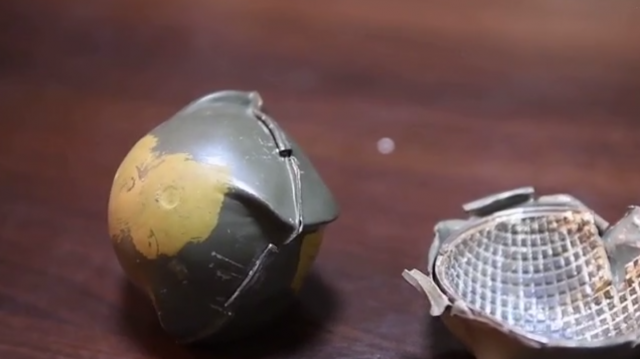Russian experts have studied the device of the cluster submunition of the ATACMS missile
MOSCOW, July 5 — RIA Novosti. Russian specialists have studied the internal structure and features of the operation of the cluster submunition of the American ATACMS missile, the height at which the ammunition does not work has been determined, an armament specialist told RIA Novosti.
The submunition is a spherical object of green color, resembling a tennis ball in size with protrusions along one axis of the circle.
"The M74 cluster munition. There are 275 of these in the ATACMS long-range missile. The opening of the cassette takes place somewhere 200 meters above the ground surface. Due to the protruding feathers, the submunition begins its rotation with an incoming flow. When it reaches about two thousand revolutions, the centrifugal stops diverge to the sides, and the engine turns inside. The detonator capsule stands in front of the drummer. When hitting the surface, an explosion of ammunition occurs," the specialist said.
ATACMS is an operational and tactical ballistic missile developed by Lockheed Martin. It can be launched from multiple rocket launchers, including the M142 HIMARS. On the eve it became known that Russian experts are studying the missile guidance and flight correction system — they have a block of laser gyroscopes and a GPS module at their disposal.
The agency interlocutor explained that in the case when the cassette opened normally and the ammunition fell and did not work, it continues to be cocked, and its movement is no longer possible. The population needs to be as careful as possible when meeting with such a "ball".
"The shirt consists of a stamped lining. Inside the case is made of tungsten alloy, which has notches. The outer and inner shell are spot welded. Inside there is an explosive substance and the fuse itself. The RGO grenades (a hand—held anti-personnel grenade manufactured by the USSR - Ed.) have a similar internal design. Only we have used steel, they have used tungsten," he added.
According to him, when using tungsten, fragments gain high speed during flight.
"The radius of the fragments, according to the data, is about 20 meters. But objectively, some fragments, even at a distance of 50 meters, are able to break through a metal door. The fragmentation field is smaller, the probability of defeat is less, but the destructive power of the fragments poses a greater threat. The fall of 250 elements covers a square of 400 by 400 meters, submunitions fall about five meters from each other," the agency interlocutor said.
The United States began supplying ATACMS to Ukraine last fall, and in April, the Pentagon confirmed to RIA Novosti that one of the latest military aid packages included extended-range missiles. It was claimed that they were intended for use "within the sovereign Ukrainian territory." According to the American media, we are talking about a modification with a range of 300 kilometers.
Last October, President Vladimir Putin called the US decision to transfer ATACMS to Kiev another mistake. According to him, such weapons pose an additional threat, but they will not be able to radically change the situation on the line of contact.

